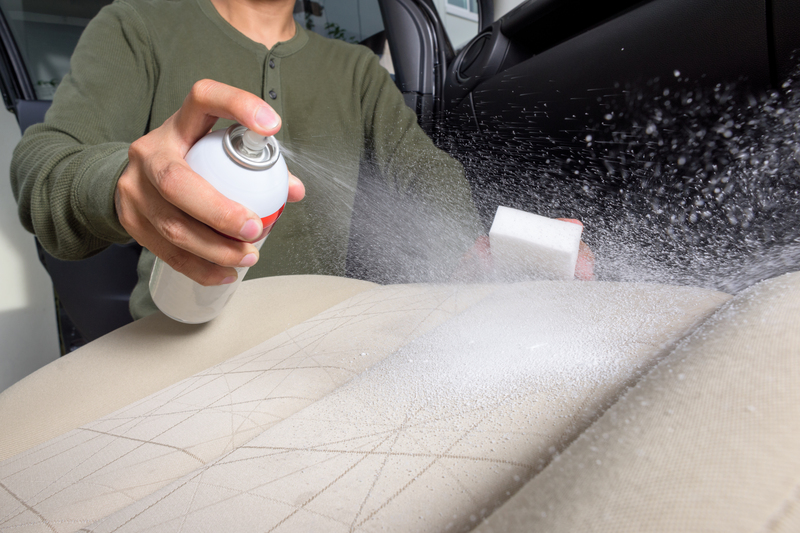Unmasking Freshness: Strategic Damp Smell Removal
Posted on 11/06/2025
Unmasking Freshness: Strategic Damp Smell Removal
There's nothing more off-putting than entering a room, closet, or car and being greeted by an unpleasant damp or musty odor. These persistent smells not only affect comfort and air quality but can also alert you to underlying problems such as excess moisture or hidden mold growth. In this guide, we embark on a comprehensive journey to "unmask" true freshness with proven strategies for effective damp smell removal, prevention, and long-term odor control solutions.

Understanding the Origins of Damp Smells
Damp smells (also referred to as musty or moldy odors) have specific root causes. Before you can strategically banish them, it's crucial to understand their origins. Identifying the source is half the battle for successful damp smell elimination.
What Causes Damp Odors?
- Excess Moisture: Poor ventilation or leaks can lead to wet conditions ideal for odor-producing bacteria and fungi.
- Mold and Mildew: Fungal growths thrive in humid environments, releasing volatile organic compounds (VOCs) that result in a musty scent.
- Poor Air Circulation: Stagnant air allows moisture (and accompanying smells) to linger.
- Organic Residue: Spilled drinks, pet accidents, or even forgotten laundry can signal bacteria to flourish and emit unpleasant smells.
Unmasking freshness isn't just about covering up unpleasant odors--it's about dealing with these root causes strategically for permanent damp smell removal.
Step-by-Step Guide: Strategic Damp Smell Removal
Ready to return your living and working spaces to their freshest state? Follow these precise, strategic steps for complete damp odor removal:
Step 1: Locate and Address the Moisture Source
Begin your damp smell remediation by seeking out and rectifying the true cause of moisture:
- Inspect for leaks in pipes, roofs, windows, or basements.
- Examine problem spots like connecting walls, under sinks, or behind appliances.
- Check fabrics, carpets, and closet contents for dampness.
- Always repair or replace damaged materials that harbor moisture.
Pro Tip: Use a moisture meter on suspect surfaces to catch hidden dampness.
Step 2: Focus on Drying Out the Environment
Once the source is under control, remove excess humidity for faster odor removal:
- Open windows for cross ventilation if weather allows.
- Employ fans to increase air circulation in closed-off areas.
- Use dehumidifiers to lower indoor relative humidity below 60%--essential for preventing mold regrowth.
- For isolated items (e.g., shoes, bags, books), place them outdoors in sunlight, which can help neutralize musty odors via UV rays.
Step 3: Deep Cleaning for Damp Smell Removal
Cleaning is fundamental for strategic damp scent elimination:
- Hard Surfaces: Clean with a solution of vinegar or baking soda to break down odor molecules. Rinse and dry thoroughly.
- Soft Furnishings: Wash fabrics in hot water. For un-washable items, consider steam cleaning or professional dry cleaning.
- Carpets and Floors: Use a carpet shampooer with an anti-microbial product or sprinkle baking soda liberally, let sit, and vacuum up residue.
- Mold Removal: Treat visible spots with a commercial anti-fungal spray or a diluted bleach solution (1 part bleach to 10 parts water). Always wear gloves and ventilate the area.
Thorough cleaning not only removes damp odors but also eliminates their microbial source, making it a crucial step towards lasting freshness.
Step 4: Natural Deodorizing Strategies
For eco-friendly damp smell removal or for those sensitive to chemicals, try these naturally effective odor absorbers and neutralizers:
- Baking Soda: Place open containers in problem areas--closets, cabinets, and cars--to passively absorb odors over days.
- Activated Charcoal: Known for its powerful adsorption, charcoal bags are reusable and ideal for long-term odor control in musty spaces.
- White Vinegar: Place small bowls in inconspicuous corners to neutralize airborne smells; the vinegar scent dissipates as it works.
- Essential Oils: Add oils such as tea tree, lavender, or eucalyptus to diffusers for a naturally fresh aroma that also combats microbes.
These low-cost, low-effort solutions work excellently in closed spaces to keep musty odors at bay.
Step 5: Improving Air Quality for Ongoing Freshness
After addressing the immediate odor, invest in strategies for continuous freshness:
- Maintain regular use of HEPA air purifiers to filter out odor-causing particulates and allergens.
- Keep up with routine cleaning schedules for all living areas, especially kitchens and bathrooms.
- Store items in breathable containers; avoid plastic bags, which can trap residual moisture.
- Rotate clothes, shoes, and linens regularly to prevent stagnation.
These measures ensure that damp odors never return and true freshness is unmasked for good!
Prevention: Keeping Damp Smells at Bay Long-Term
When it comes to lasting damp smell prevention, proactive measures are your most effective weapon:
- Regularly inspect for leaks or condensation, especially after storms, seasonal changes, or plumbing work.
- Repair cracks and seal foundation gaps to block moisture entry.
- Install exhaust fans in bathrooms, kitchens, and laundry areas to reduce humidity.
- Use moisture absorbers such as silica gel packets in drawers and storage bins.
- Monitor humidity with inexpensive hygrometers and keep it below recommended thresholds (generally 30-50%).
Tip: Home automation can help--smart dehumidifiers and sensors provide real-time alerts so you can act before smells appear.
Special Considerations: Car and Closet Odor Removal
Cars and closets are notorious for developing stubborn damp odors. Here are some targeted strategies for strategic removal:
For Cars:
- Regularly vacuum seats and carpets, especially after spills or rainy weather.
- Clean air conditioning ducts--damp, dirty filters and vents are prime sources of musty smells. Consider a professional AC cleaning once a year.
- Keep windows slightly cracked (when safe) to allow for airflow and prevent moisture build-up.
- Absorb odors with baking soda, charcoal, or dedicated car deodorizers under the seats.
For Closets:
- Leave closet doors open periodically to enhance ventilation.
- Place natural dehumidifiers, like calcium chloride crystals, on closet shelves.
- Hang sachets of cedar or lavender as both a pleasant-smelling and anti-mold measure.
- Don't over-pack closets--air must circulate freely around clothing and linens.
Myths and Mistakes to Avoid in Damp Smell Elimination
Many people fall into traps that worsen the issue or only mask odors instead of removing them. Here are common mistakes to avoid:
- Covering up the smell with sprays or air fresheners rather than solving the underlying moisture problem.
- Using bleach on porous materials (like drywall or wood), which can sometimes worsen mold issues if not rinsed thoroughly.
- Ignoring minor leaks, thinking they'll resolve on their own--small leaks often cause the most persistent damp odors.
- Storing items when damp: Always ensure clothes, fabrics, and other belongings are fully dry before storing them away.
- Disregarding regular maintenance--long-term freshness requires consistency.
Frequently Asked Questions on Strategic Damp Smell Removal
How long does it take to remove a damp smell?
Removal time varies depending on the severity and cause, but with thorough intervention, many cases resolve within a few days to a week. Persistent smells linked to structural moisture may require more extensive remediation.
Are store-bought odor removers effective for musty odors?
Some commercial odor eliminators work well as supplements for neutralizing airborne smells, but true damp odor removal always begins with eliminating the source of moisture or mold.
Is it possible to remove damp odors permanently?
Yes--when moisture sources are corrected and spaces are kept clean and dry, musty odors should not return. Regular preventive maintenance is the key to permanent freshness.
The Science of Freshness: Why Strategic Odor Removal Works
Scientific research shows that most "musty" indoor smells stem from airborne byproducts of mold, mildew, and bacterial metabolism in damp environments. Targeted interventions such as drying, cleaning, and purifying the air attack the root causes, rather than merely masking the symptoms. This explains why strategic odor removal is so much more effective compared to superficial fixes.

Final Thoughts: Unmasking Your Home's True Freshness
Don't let stubborn damp odors define your space or undermine your comfort. By unmasking and treating the root causes, you not only restore freshness but also protect your health and the integrity of your home. Adopt these strategic approaches to damp smell removal for a living environment that is clean, welcoming, and truly fresh--all year round.
Freshness is more than a scent; it's a state of mind--one you can achieve through knowledge, action, and ongoing care. Start your journey to a fresher space today!
Key Takeaways for Strategic Damp Smell Removal
- Identify and eliminate moisture sources--this step is essential for removing existing odors and preventing future ones.
- Dry and ventilate affected spaces as quickly as possible.
- Deep clean all contaminated surfaces, fabrics, and carpets. Use anti-fungal products where needed.
- Adopt natural deodorizers for ongoing musty odor prevention--baking soda, charcoal, and essential oils are excellent options.
- Implement a regular maintenance routine: monitor for leaks, clean and declutter regularly, and control indoor humidity levels.





